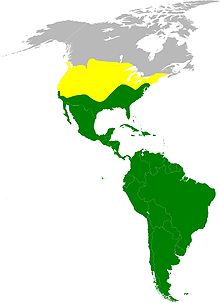Cathartes
| Cathartes | |
|---|---|
 |
|
| Turkey vulture in Morro Bay, California | |
| Scientific classification | |
| Kingdom: | Animalia |
| Phylum: | Chordata |
| Class: | Aves |
| Order: | Cathartiformes |
| Family: | Cathartidae |
| Genus: |
Cathartes Illiger, 1811 |
| Species | |
|
C. aura (Linnaeus, 1758) |
|
 |
|
| Approximate distribution of the genus Cathartes. Green indicates that at least one species is resident year-round and yellow shows areas where one species, the turkey vulture, is a summer-only breeding visitor. | |
C. aura (Linnaeus, 1758)
C. burrovianus Cassin, 1845
C. melambrotus Wetmore, 1964
The genus Cathartes includes medium-sized to large carrion-feeding birds in the New World vulture (Cathartidae) family. The three species currently classified in this genus occur widely in the Americas.
Cathartes is the Greek word καθαρτής, for "purifier," referring to these vultures' role as "cleansers" that "tidy up" decomposing corpses in nature.
Cathartes is one of the five genera of New World vultures. The taxonomic placement of these vultures remains unclear. It is the only genus in its family that is not monotypic. The New World and Old World vultures are similar in appearance and have similar ecological roles, but evolved from different ancestors in widely separated parts of the world. The relationships between the two vulture groups is a matter of debate, with some earlier authorities suggesting that the New World vultures are more closely related to storks.
In 2007 the American Ornithologists' Union's North American checklist moved Cathartidae back into the lead position in Falconiformes, but with an asterisk that indicates it is a taxon "that is probably misplaced in the current phylogenetic listing but for which data indicating proper placement are not yet available". The AOU's draft South American checklist places the Cathartidae in their own order, Cathartiformes. However, recent DNA study on the evolutionary relationships between bird groups also suggests that they are related to the other birds of prey and should be part of a new order Accipitriformes instead, a position adopted in 2010 by the AOU's North American check-list, and shared with the International Ornithological Congress.
...
Wikipedia
